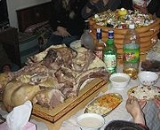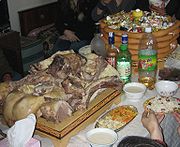
Tsagaan Sar
Encyclopedia

Mongols
Mongols ) are a Central-East Asian ethnic group that lives mainly in the countries of Mongolia, China, and Russia. In China, ethnic Mongols can be found mainly in the central north region of China such as Inner Mongolia...
. Today, Mongols are found in Mongolia
Mongolia
Mongolia is a landlocked country in East and Central Asia. It is bordered by Russia to the north and China to the south, east and west. Although Mongolia does not share a border with Kazakhstan, its western-most point is only from Kazakhstan's eastern tip. Ulan Bator, the capital and largest...
, Inner Mongolia
Inner Mongolia
Inner Mongolia is an autonomous region of the People's Republic of China, located in the northern region of the country. Inner Mongolia shares an international border with the countries of Mongolia and the Russian Federation...
, Buryatia
Buryatia
The Republic of Buryatia is a federal subject of Russia . Its capital is the city of Ulan-Ude. Its area is with a population of 972,658 .-Geography:...
and Kalmykia
Kalmykia
The Republic of Kalmykia is a federal subject of Russia . Population: It is the only Buddhist region in Europe. It has also become well-known as an international chess mecca because its former President, Kirsan Ilyumzhinov, is the head of the International Chess Federation .-Geography:*Area:...
. It is often celebrated around the same time as the Chinese New Year
Chinese New Year
Chinese New Year – often called Chinese Lunar New Year although it actually is lunisolar – is the most important of the traditional Chinese holidays. It is an all East and South-East-Asia celebration...
(sometimes a lunar month later). However, the Mongol Tsagaan Sar is culturally more related to the Tibetan New Year than to the Chinese New Year.
The White Moon holiday is celebrated two months after the first new moon following the winter solstice
Winter solstice
Winter solstice may refer to:* Winter solstice, astronomical event* Winter Solstice , former band* Winter Solstice: North , seasonal songs* Winter Solstice , 2005 American film...
. In 2009, White Moon fell on February 25, and in 2010, it will be on February 14. Tsagaan Sar is one of the most important Mongol holidays.
Around the New Year families burn candles at the altar symbolising enlightenment
Enlightenment in Buddhism
The English term enlightenment has commonly been used in the western world to translate several Sanskrit, Pali, Chinese and Japanese terms and concepts, especially bodhi, prajna, kensho, satori and buddhahood.-Insight:...
. Also people greet each other by saying 'Amar mend uu?' or 'Amar bain uu?', a very formal greeting which one says to one's elders. Mongols also visit friends and family on this day and exchange gifts. A typical Mongol family will meet in the home dwelling of the eldest in the family. Many people will be dressed in full garment of national Mongol costumes. When greeting their elders during the White Moon festival, Mongols grasp them by their elbows to show support for them. The eldest receives greetings from each member of the family except for his/her spouse. During the greeting ceremony, family members hold long pieces of colored cloth called khadag. After the ceremony, the extended family eats rice with curds, dairy products and buuz and drinks airag
Airag
Airag may refer to*Airag, also spelled ayrag, the Mongolian word for fermented horse milk; see kumis, the name under which it is more widely known throughout Central Asia. It is an alcoholic spirit that people drank in the Khan era....
, and exchanges gifts.
The day before Tsagaan Sar is called Bituun
Dark moon
A dark moon describes the Moon during that time that it is invisible against the backdrop of the Sun in the sky. The duration of a dark moon is between 1.5 and 3.5 days, depending on the orientation of the Earth and Sun....
, the name of the lunar phase of dark moon. The lunar phases are Bituun (dark moon), Shined (new crescent moon), Tergel (full moon), and Huuchid (waxing moon). On the Bituun day, people thoroughly clean around home, herders also clean the livestock barns and shades, to meet the New Year fresh. The Bituun ceremony also includes burning candles to symbolize enlightenment of the samsara and all sentient beings and putting 3 pieces of ice at the doorway so that the horse of the deity Palden Lhamo could drink as the deity is believed to visit every household on this day. In the evening, families gather together--immediate family usually, in contrast to the large feast gatherings of White Moon day--and see out the old year eating dairy products and buuz. Traditionally, Mongolians settle all issues and repay all debts from the old year by this day.
Traditional food for the festival includes dairy products, rice with curds (tsagaa-цагаа) or rice with raisin (berees-бэрээс), a pyramid of traditional cookies erected on a large dish in a special fashion symbolising Mount Sumeru or Shambhala
Shambhala
In Tibetan Buddhist tradition, Shambhala or Shangri-la is a mythical kingdom hidden somewhere in Inner Asia...
realm, a grilled side of sheep and minced beef or minced mutton steamed inside pastry, a dish known as buuz
Buuz
Buuz are a type of Mongolian steamed dumpling filled with minced mutton, or beef meat. The meat is flavoured with onion or garlic and salted. Occasionally, they are flavoured with sprouted fennel seeds and other seasonal herbs...
, horse meat and traditional cookies. Tsagaan Sar is a lavish feast, requiring preparation days in advance, as the women make large quantities of buuz and freeze them to save for the holiday.
During Mongolia's Communist period, the government banned Tsagaan Sar and tried to replace it with a holiday called "Collective Herder's Day", but the holiday was practiced again after the 1990 Democratic Revolution in Mongolia
1990 Democratic Revolution in Mongolia
The 1990 Peaceful Democratic Revolution in Mongolia was a democratic revolution that started with hunger strikes to overthrow the Mongolian People's Republic and eventually moved towards the democratic present day Mongolia and the writing of the new constitution. It was spearheaded by mostly...
.
Dates
The Mongol calendarMongolian calendar
The Mongol calendar is a lunisolar calendar based on system developed in 1747 by monk Ishbaljir . The Mongol year is composed of either 12 or 13 lunar months, each beginning and ending with a new moon...
in the Tegus Buyantu (Төгсбуянт) system is a lunisolar calendar
Lunisolar calendar
A lunisolar calendar is a calendar in many cultures whose date indicates both the moon phase and the time of the solar year. If the solar year is defined as a tropical year then a lunisolar calendar will give an indication of the season; if it is taken as a sidereal year then the calendar will...
. Tsagaan Sar is celebrated on the first through third days of the first lunar month
Lunar month
In lunar calendars, a lunar month is the time between two identical syzygies . There are many variations. In Middle-Eastern and European traditions, the month starts when the young crescent moon becomes first visible at evening after conjunction with the Sun one or two days before that evening...
.
| Gregorian Gregorian calendar The Gregorian calendar, also known as the Western calendar, or Christian calendar, is the internationally accepted civil calendar. It was introduced by Pope Gregory XIII, after whom the calendar was named, by a decree signed on 24 February 1582, a papal bull known by its opening words Inter... year |
Mongol year | Tsagaan Sar* | Element and animal |
|---|---|---|---|
| 1989 | Цагаан | February 7 - February 10 | female earth snake |
| 1990 | Машид согтонги | February 26 - February 28 | male iron horse |
| 1991 | Төрөлхтний эзэн | February 15 - February 17 | female iron sheep |
| 1992 | Ангира | February 4 - February 7 | male water snake |
| 1993 | Цогт нигурт | ... | female water ape |
| 1994 | Бода | February 11 - February 13 | male wooden dog |
| 1995 | Насан төгөлдөр | ... | female wooden hog |
| 1996 | Баригч | February 19 - February 21 | male fire mouse |
| 1997 | Эрхэт | February 8 - February 10 | female fire cattle |
| 1998 | Олон үрт | ... | male earth tiger |
| 1999 | Согтох төгөлдөр | February 17 - February 19 | female earth rabbit |
| 2000 | Тийн дарагч | ... | male iron dragon |
| 2001 | Сүргийн манлай | January 24 - January 26 | female iron snake |
| 2002 | Элдэв | February 13 - February 15 | male water horse |
| 2003 | Наран | February 2 - February 4 | female water sheep |
| 2004 | Наран гэтэлгэгч | February 21 - February 23 | male wood ape |
| 2005 | Газар тэтгэгч | February 9 - February 11* | female wood rooster |
| 2006 | Барагдашгүй | January 30 - February 1 | male fire dog |
| 2007 | Хамгийг номхотгогч | February 18 - February 20 | female fire hog |
| 2008 | Хотолыг баригч | February 8 - February 10 | male earth mouse |
| 2009 | Харшлалт | February 25 - February 27 | female earth cattle |
| 2010 | Тийн урвагч | February 14 - February 17 | male iron tiger |
| 2011 | Илжиг | February 3 - February 5 | female iron rabbit |
| 2012 | Not announced | February 22 - February 25 | male water dragon |
- * Note: The start date of Tsagaan Sar depends on longitude. For example, in 2005, Tsagaan Sar on February 8 in most of the United StatesUnited StatesThe United States of America is a federal constitutional republic comprising fifty states and a federal district...
and February 9 in much of AsiaAsiaAsia is the world's largest and most populous continent, located primarily in the eastern and northern hemispheres. It covers 8.7% of the Earth's total surface area and with approximately 3.879 billion people, it hosts 60% of the world's current human population...
.

